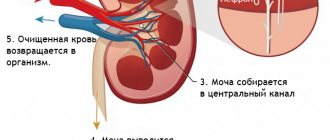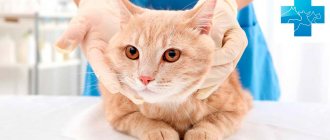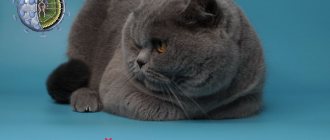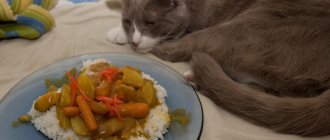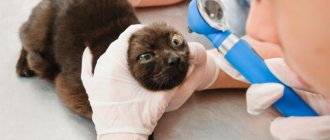Reading time: 5 minute(s) If your pet exhibits symptoms of kidney failure, contact your veterinarian immediately. Without treatment, serious complications are possible.
If the diagnosis of “renal failure” is left without proper attention or is not responded to in a timely manner, the cat’s health will deteriorate sharply, and even death is possible. There is no need to take risks; it is better to contact a veterinarian at the first suspicion. An experienced specialist will accurately determine the stage of the disease, prescribe an effective course of treatment, and advise proper nutrition. In general, he will do everything possible to ensure that the pet is cheerful, cheerful and healthy again.
CRF is a deadly pathology
Why is kidney failure dangerous for cats?
Kidney failure in cats requires treatment as soon as possible. And these are not empty threats. Every day the urinary system will work worse, and more toxic substances will accumulate in the body. They are not excreted; they poison internal organs and blood. Also, the kidneys stop coping with such tasks as:
- control of sodium intake into the blood (important for lowering and increasing blood pressure);
- regulation of fluid in muscle tissue;
- production of vital hormones;
- removal of toxins after drug treatment.
Genitourinary system of cats
There are cases when a pet fades away in a few days, and such consequences are real in both acute and chronic renal failure. Another problem is misdiagnosis. Signs of the disease often overlap with symptoms of other ailments, so the doctor’s experience is important here.
Causes of kidney diseases
Chronic kidney disease in cats is common in older animals.
Causes of diseases in pets:
- nephritis;
- fibrosis of renal tissue;
- toxic effect of drugs;
- oxygen starvation;
- glomerulonephritis;
- pyelonephritis;
- viral diseases.
https://www.instagram.com/p/Byst6mkIakS/
Often a cat’s kidneys fail because he has the following diseases:
- amyloidosis;
- polycystic kidney disease;
- benign tumor;
- nephropathy;
- congenital pathology.
Diseases and injuries of the urinary organs often lead to the development of chronic renal failure in cats.
Kidney Failure in Cats: Symptoms and Signs
Kidney failure may not manifest itself for a long time, and only after about 70% of the kidneys' performance is lost does the disease make itself felt. The early stages of the disease are accompanied by changes in the composition and color of the animal's urine. Do you have even the slightest doubt about this issue? It is better to immediately conduct a special laboratory analysis.
Keep a close eye on your pet
The following symptoms will help you recognize kidney failure in cats:
- weakness, bad breath, refusal to eat and play actively;
- drinking large amounts of water and urinating frequently;
- diarrhea, vomiting, painful cramps (often appear at the terminal stage of the disease);
- spontaneous increase in blood pressure, ruptures of blood vessels in the eyes;
- elevated body temperature, tremors, strange behavior.
The more the body is exposed to toxins, the more pronounced the signs of kidney failure become. It is also recommended to sound the alarm in advance if you initially know that your pet has ailments such as diabetes, pneumonia, piroplasmosis, and enteritis.
Slags
Many household items can damage your kidneys, not just antifreeze. Petals, leaves and pollen from lilies, even water in their vase, can cause serious kidney injury when cats nibble, lick or chew the flowers or come into contact with water. This is one type of flower that you should avoid completely if you have a cat! Common OTC medications such as aspirin, other nonsteroidal drugs (NSAIDs), or prescription drugs can all cause kidney disease. Cats, who are known for being picky about food and just about everything else, will still eat pills they find in your medicine cabinet or on the floor, so keep all medications in cat-proof containers. And always discuss the use of any medications with your veterinarian.
If you have any reason to believe that your cat has been poisoned, call your veterinary emergency number immediately for help. Contact us at the following numbers:
8-495-221-81-90
8-495-221-84-70
8-499-136-19-18
Chronic and acute renal failure in cats: how to treat
The choice of treatment method directly depends on the animal’s health condition and the type of renal failure. For example, in case of a chronic illness, it will no longer be possible to restore the kidneys, since, unfortunately, this is an irreversible process. If acute deficiency is diagnosed, complete recovery is possible.
When diagnosed with acute renal failure in cats, an experienced specialist does not have the question of how to treat the animal? The treatment, rehabilitation and prevention regimen is chosen individually. Common methods:
- to restore the required amount of fluid in the body, droppers are prescribed (intravenous nutrition);
- at the initial stage of the disease, the doctor prescribes antibiotics and vitamin injections;
- in order to normalize blood pressure and prevent damage to capillaries, special heart medications are used;
- in some cases, artificial blood purification and blood transfusion are prescribed (especially important in chronic renal failure).
If the pet is in pain, painkillers are prescribed, and nerve endings may be blocked. Treatment methods cannot be chosen without diagnostic data, because for high blood pressure some medications are suitable, for anemia - completely different ones, for concomitant kidney problems - still others.
Infection of the kidney tissue (pyelonephritis)
Infection of kidney tissue by bacteria or, less commonly, fungal organisms is one of the kidney diseases that may have a more favorable outcome, so your veterinarian will be on the lookout. Our goal when treating pyelonephritis is to kill the bacteria that cause destructive inflammation. This should limit the progression of any chronic kidney disease or aid in recovery from acute kidney injury. Urine bacterial culture and susceptibility can determine the type of infection and determine which antibiotic may work best.
How long do cats with kidney failure live?
If we are talking about acute renal failure, then with proper treatment, the animal will return to a full life. Although, since the pathology of renal failure is not eliminated, the cat will always require careful care - diet, periodic visits to the veterinarian. If the disease has reached the terminal stage of chronic renal failure, then, unfortunately, treatment will no longer help. It is unknown how long the pet will live at this stage. It depends on his age, the condition of other organs, and care. In the most severe manifestations of the terminal stage, the animal is euthanized, since chronic renal failure is accompanied by excruciating pain.
An animal with chronic renal failure can fade away in a matter of days
Renal obstruction (ureteral obstruction with hydronephrosis)
Kidney stones can fragment and travel through urine into the ureter, the long, narrow tube that connects each kidney to the bladder. They are likely to cause severe pain as they move, and significant difficulty in functioning results in the kidney if they become lodged in the ureter, causing partial or complete blockage. New urine cannot pass out of the kidney easily and it recedes, causing the kidneys to swell. If there is enough pressure, the kidneys become enlarged (hydronephrosis) and damaged. If both ureters become blocked at the same time, this can lead to catastrophic consequences, including death.
Cat with chronic renal failure: stages of the disease and signs
The big problem with chronic renal failure is that it is very difficult to diagnose the disease in the early stages. There are no special external manifestations; chronic renal failure can only be determined by regularly taking tests. Therefore, most often, at the time of diagnosis, the kidneys are already more than half affected and the animal requires serious treatment. And if you delay, a fatal outcome cannot be avoided. In total, there are 4 stages of disease development:
- compensation
- subcompensation
- decompensation
- terminal
Despite the absence of obvious symptoms of chronic renal failure in the first stages, there are signs that should attract the attention of the owner. If your cat has become less active, her appetite has decreased, and she drinks water more often, then it is worth taking blood tests. If creatinine values are elevated, do a more in-depth examination, including an ultrasound of the kidneys. In the early stages, CRF can progress slowly over months, and the sooner the owner begins treatment, the higher the chances of a positive outcome.
Treatment of acute renal failure has a much higher chance of success
If you have end-stage chronic renal failure, the maximum that a veterinarian can offer you is hemodialysis and surgery. Neither one nor the other gives a 100% guarantee of the survival of the animal. Doctors often recommend euthanizing a cat in order to save both it and its owner from prolonged suffering.
Diagnosis and treatment
Pet owners ask the veterinarian how they can help if their cat has kidney failure. Conservative therapy is used to eliminate metabolic disorders and maintain kidney function. They use a diet, limit protein, regulate the exchange of phosphorus and calcium.
To establish hyper- or hyponatremia, a blood test (biochemical) is taken. Plasma pH is determined to eliminate acidosis. Early diagnosis of chronic renal failure is based on the appearance of anemia, polyuria and hypertension in the animal. Conduct laboratory and biochemical studies:
- urine density;
- glomerular filtration level;
- creatinine values.
The veterinarian needs to solve the problems of conservative therapy:
- slow down the development of chronic renal failure;
- restore electrolyte balance;
- correct hormonal and metabolic disorders;
- perform an ultrasound of the kidneys.
To treat kidney failure use:
- To eliminate azotemia, use the laxative medication Duphalac from 1 to 5 ml 1-2 times a day. Enterodes is prescribed, which is taken 2 hours after meals.
- Benazepril is prescribed for the treatment of hypertension; the drug prevents protein loss. The medication is used in a dose of 0.25-1.0 mg/kg 1 time per day orally.
- To eliminate the increased amount of phosphates, aluminum hydroxide 2.5 mg/kg is prescribed once a day.
- Erythropoietin-related medications are used to treat anemia. If the hematocrit is 15%, a hormone is used. Epogen is used for treatment at a dose of 100 units/kg 3 times a day according to the regimen.
- Prescribe ferrous sulfate 50-100 mg once a day.
IVs are given to the pet in case of dehydration, with high levels of creatinine and urea. The animal is administered Ringer's solution and 0.9% sodium chloride solution through a catheter. The amount of drug administered depends on the weight of the animal.
In case of complications such as stomatitis or gastroenteritis, the pet is given Ranitidine 1-2 mg/kg 2 times a day. To maintain the required amount of the mineral in the blood, potassium gluconate is prescribed 2 mg 2 times a day. Potassium citrate is added to food to eliminate metabolic acidosis. In case of chronic renal failure, the animal is placed in the physiotherapy department for treatment with the Vitafon apparatus.
Diet and food
Therapy should be supplemented with proper nutrition. When a cat refuses food, its body quickly becomes exhausted. Therefore, even force feeding would be appropriate. If tests show a urea level of less than 20 mol/l, super premium quality wet food can be used. When the condition stabilizes, a transition to dry food is possible.
With data of 30 mol/liter, a strict protein-free diet based on sweetened foods and flour products is indicated. If your pet is not picky about food, then bread, oatmeal pancakes, pasta with vegetable oil may suit him. If he does not eat such food, then they give him diluted canned food for cats. To support the stability of digestion, Creon and Mezim are prescribed.
If the animal has no appetite, then it still needs to be fed. For this purpose, a special nutritional mixture is made:
- Purified water (100 ml) is mixed with the same amount of milk with a fat content of 2.5%.
- Add a tablespoon of sugar and a teaspoon of potato starch.
- The resulting suspension is boiled and cooled.
- Beat in one raw chicken egg and one crushed Mezim tablet.
The mixture is mixed with special care and given to the animal through a syringe, 5 ml every 60-70 minutes. As soon as vomiting decreases or disappears and health improves, the dose is increased, while the intervals between meals are reduced. Once the condition has stabilized, you can switch the cat to wet food.
Treatment of kidney disease in cats must be carried out by a veterinarian. The effects of medications are monitored by testing and their results. At home, providing timely assistance to your pet is impossible and can be fatal for it.
It is necessary to regularly undergo control tests at the animal medical center. At the first signs of the disease, further degeneration of kidney tissue can be prevented and maintenance treatment can be avoided. Special control is needed for pets of the Persian breed.
Standard for organizing therapeutic nutrition for diseases of the kidneys and urinary tract
Structure of the clinical nutrition standard
- Classification of diseases according to ICD-10 codes.
- Basic principles of therapeutic nutrition.
- Technology of forming groups of patients for therapeutic nutrition.
- Basic requirements for prescribing standard diets: indications for prescribing, options for standard diets with average daily food sets, correction with dry composite protein mixtures.
- Basic requirements for prescribing special diets: indications for prescribing, options for special diets with average daily food sets, correction with dry composite protein mixtures.
- Basic requirements for prescribing individual diets: indications for prescription, options for standard diets with average daily food sets, correction with dry composite protein mixtures.
- Indications for prescribing enteral nutrition.
- Indications for prescribing parenteral nutrition.
- Indications for inclusion of biologically active additives in diets.
Prevention
It is better to prevent kidney disease than to later treat an animal for a fatal disease. Following simple recommendations regarding your pet’s health will help you avoid this unpleasant disease:
- Compliance with safety measures. We must try to prevent them from injury, poisoning, bites, and self-medication with medications.
- Self-medication is excluded for diagnosed urolithiasis; therapy is prescribed only by a veterinarian.
- Timely diagnosis and treatment of infectious processes of the genitourinary system.
- Losing weight if your cat is overweight.
- Strictly follow the recommendations given by the doctor for diabetes mellitus in a cat.
1111

